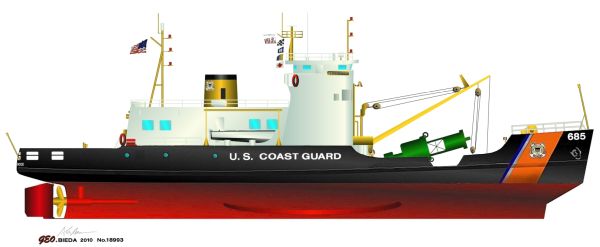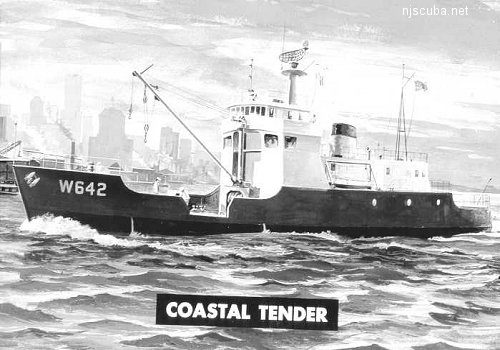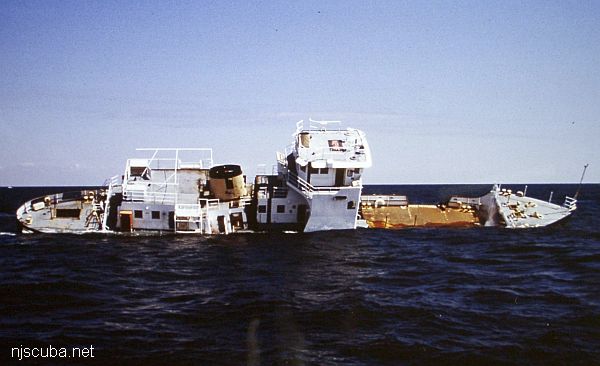Red Oak WLM-689

- Type:
- artificial reef, buoy tender / ice breaker, US Coast Guard
- Built:
- 1971, US Coast Guard Yard, Baltimore MD
- Specs:
- ( 157 x 33 ft )
- Depth:
- 65 ft
- Sponsor:
- USCG, Dick Weber & South Jersey Fishing Center
- Sunk:
- Monday September 13, 1999 - Cape May Artificial Reef
- GPS:
- 38°53.125' -74°40.816'

The ice-breaking bow is designed to ride up on ice and then break it by the weight of the ship, hence the odd shape.

New 157-Ft. Coastal Buoy Tender
Shown here is an artist's conception of the U.S. Coast Guard's newly designed 157-ft. coastal buoy tender which is being built to fill a need for a tender of a size between the seagoing 180-foot class and smaller inland tenders. Features of the new coastal tender include a reinforced hull for light icebreaking work, twin controllable pitch propellers, a bow thruster unit to increase maneuverability, steering, and engine control stations on each bridge wing in addition to the pilothouse stations and lever control stations instead of the usual wheel. Her design calls for a 10-ton boom hydraulically powered and controlled from either of two enclosed stations built into the superstructure just below bridge deck level. Also, comfortable air-conditioned quarters will accommodate a crew of 32 officers and men. The first of the 157-ft. tenders is being constructed at the U.S. Coast Guard Yard, Curtis Bay, Md. and is expected to be completed in September 1964.
The Red Oak was the fifth of five 157-foot coastal buoy tenders built by the Coast Guard Yard that entered service between 1964 and 1971. They were the first new class of seagoing buoy tenders of the post-World War II era that were designed and constructed by the Coast Guard. This class of tender was designed to service aids to navigation up to 10-tons and, with a draft of only seven feet, to operate in shallow waters often encountered on the sides of dredged harbor channels. They were designed with low bows that allowed maximum visibility around approaching buoys and had a bow thruster unit recessed into their hulls and twin controllable-pitch propellers to increase maneuverability. Their hulls were reinforced for light icebreaking.
The conventional ship's wheel was absent, being replaced by a simple tiller. The hydraulic steering system provided a change from full left to full right rudder in six seconds. One press release stated that the crew " ... would enjoy a new concept in comfort provided by their modernistic living quarters. All living spaces are air-conditioned, paneled in maintenance-free plastic laminates and finished in bright colors." All weight handling gear was operated by hydraulic motors utilizing an advanced pneumatic control system. Each tender was assigned to tend aids to navigation in coastal waters while being "always ready" to carry out other traditional Coast Guard duties such as fighting fires and conducting law enforcement, environmental protection and search and rescue operations when required.
Red Oak's keel was laid on 26 October 1970 and the first welding arc was struck by Mrs. Elislea A. Brown. She was launched on 19 June 1971 and was christened on that date by Mrs. John E. Hunt. The Red Oak was commissioned on 17 December 1971 and was assigned to Gloucester City, New Jersey, and was placed under the operational control of the Third [later the Fifth] Coast Guard District. She was assigned to tend aids to navigation on the Delaware River, from the Ship John Shoal light to Trenton, New Jersey, which contained a total of 175 lighted aids. She also refueled the lighthouse at Brandywine Shoal. She was supported by the Aids to Navigation Team [ANT] RED OAK, which consisted of seven enlisted men and two civilians who were based ashore. This subunit of Red Oak had a 45-foot buoy boat, a trailerable 21-foot AtoN boat [TANB], and a 14-foot aluminum hull attached to it.
She was awarded the Coast Guard Meritorious Unit Commendation for her "excellent and professional performance during the period 31 January to 28 February 1975 in containing and reducing the damage inflicted on the estuarine environment by the spillage of 150,000 gallons of crude oil" caused by the collision of two petroleum cargo vessels. She received her second Coast Guard Meritorious Unit Commendation "for her valiant and diligent efforts in replacing the many Aids to Navigation moved off station during the ice season of 4 January to 31 March 1977. Her tireless efforts enabled ports along the Delaware to remain open for commerce."
She was awarded a Coast Guard Unit Commendation for her "meritorious service as on-scene commander, directing the rescue and firefighting efforts of 10 civilian and Coast Guard vessels following the explosion of a barge carrying 10,000 barrels of JP4 jet fuel on 20 March 1978." She earned her third Coast Guard Meritorious Unit Commendation in 1981 for "her support of Coast Guard Aids to Navigation during the period from 3 December 1979 to 1 June 1981. Red Oak and ANT RED OAK affected significant improvements in the Aids to Navigation system and kept the river open to commercial traffic during the severe ice season of 1980-81."
She remained home-ported at Gloucester City until the Coast Guard closed Base Gloucester City in 1988. She then moved to a new facility in Philadelphia, where she remained based for the remainder of her Coast Guard career. She was decommissioned on 28 March 1996 due to mandated reductions in the FY-96 budget and the ongoing buoy tender replacement project. She was scuttled in 1999.
-- from Coast Guard historical records


The Red Oak lies upright in 65 ft of water. She was sunk with a number of nice artifacts still intact, including several portholes.


Questions or Inquiries?
Just want to say Hello? Sign the .